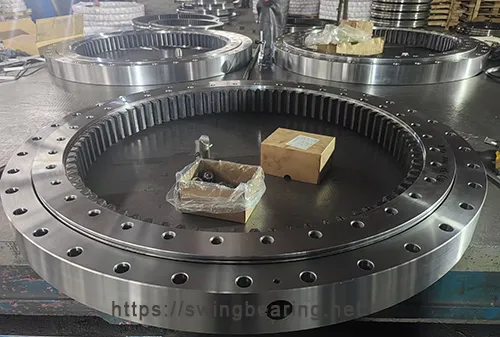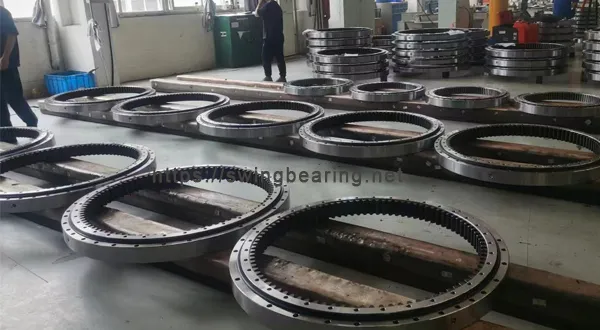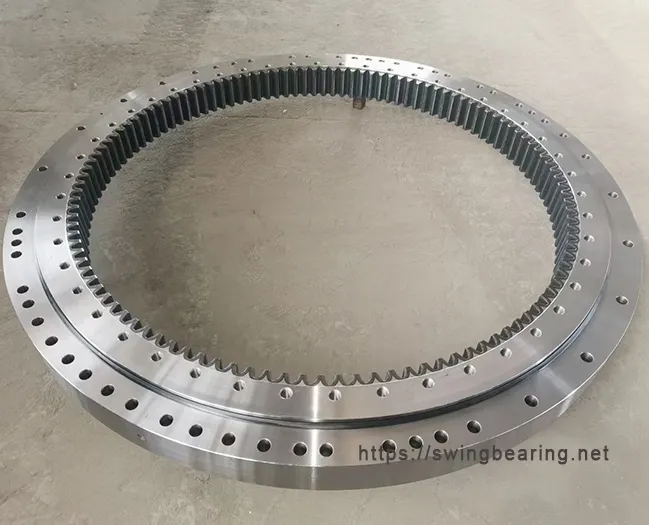
Understanding the intricate interactions within an excavator’s upper structure is crucial for appreciating how these powerful machines operate. At the heart of these interactions lies the swing bearing, a pivotal component that enables smooth and precise movements. This blog explores how the cojinete basculante interacts with other components of the excavator’s upper structure during operation, shedding light on its vital role in maintaining stability and efficiency.
The swing bearing, often referred to as the slewing ring, is a fundamental component that facilitates the rotation of the excavator’s upper structure. It is strategically positioned between the excavator’s upper frame and the undercarriage, allowing the upper structure to pivot seamlessly. This rotation is essential for the excavator’s ability to perform tasks such as digging, lifting, and swinging materials.
The excavator boom is directly influenced by the swing bearing’s operation. The boom’s primary function is to extend and retract, allowing the excavator to reach various depths and distances. The swing bearing enables the boom to pivot around the excavator’s base, providing a wide range of motion. This interaction is crucial for tasks that require precise positioning, such as trenching and lifting heavy loads.
The hydraulic system of an excavator plays a critical role in its overall functionality. The swing bearing is closely linked to this system, as it relies on hydraulic fluid to operate efficiently. Hydraulic motors drive the rotation of the swing bearing, converting hydraulic energy into mechanical motion. This seamless integration ensures that the excavator’s upper structure can rotate smoothly and responsively.
The operator’s cabin, where the controls are located, is an integral part of the excavator’s upper structure. The swing bearing allows the cabin to rotate in unison with the boom and other attachments. This synchronization is essential for providing the operator with a clear line of sight and precise control over the machine’s movements. The smooth rotation facilitated by the swing bearing ensures that the operator can perform tasks with accuracy and efficiency.
The swing bearing’s interaction with other components is crucial for maintaining the excavator’s structural stability. It distributes the loads and forces exerted during operation evenly across the upper structure, preventing undue stress on any single component. This balanced distribution enhances the excavator’s overall stability, reducing the risk of tipping or structural damage.

The counterweight is another vital component that interacts with the swing bearing. Positioned at the rear of the excavator, the counterweight balances the machine’s weight and enhances stability. The cojinete basculante allows the counterweight to rotate along with the upper structure, ensuring that the excavator remains well-balanced during operation. This interaction is particularly important when the excavator is lifting heavy loads or working on uneven terrain.
Regular maintenance of the swing bearing is essential for ensuring its longevity and optimal performance. The interaction between the swing bearing and other components requires careful monitoring and lubrication. Neglecting maintenance can lead to increased friction and wear, compromising the bearing’s functionality and the excavator’s overall efficiency. Proper maintenance practices, such as regular inspections and lubrication, help extend the swing bearing’s lifespan and enhance its interaction with other components.
Lubrication is critical for the slewing bearing’s smooth operation. The bearing must be adequately lubricated to reduce friction and prevent wear. Additionally, proper sealing is necessary to keep contaminants out of the bearing assembly. The interaction between the slewing bearing and lubrication systems ensures that the bearing remains in optimal condition, facilitating smooth rotation and efficient performance.
The slewing bearing plays a vital role in distributing loads and managing stress within the excavator’s upper structure. During operation, the excavator encounters various forces, including axial and radial loads. The swing bearing evenly distributes these forces across the upper structure, preventing localized stress points and reducing the risk of structural damage. This balanced load distribution enhances the excavator’s overall stability and durability.

Q1: What is the primary function of the slewing bearing in an excavator?
The swing bearing’s primary function is to facilitate the rotation of the excavator’s upper structure. It allows the upper frame, including the boom and operator’s cabin, to pivot smoothly around the excavator’s base.
Q2: How does the slewing bearing interact with the hydraulic system?
The swing bearing is driven by hydraulic motors that convert hydraulic energy into mechanical motion. This interaction enables the smooth rotation of the excavator’s upper structure, allowing precise control over the machine’s movements.
Q3: Why is regular maintenance of the slewing bearing important?
Regular maintenance, including lubrication and inspections, is crucial for ensuring the swing bearing’s longevity and optimal performance. Neglecting maintenance can lead to increased friction, wear, and compromised functionality.
Q4: How does the slewing bearing contribute to the excavator’s stability?
The slewing bearing distributes loads and forces evenly across the excavator’s upper structure, preventing undue stress on any single component. This balanced distribution enhances the excavator’s stability and reduces the risk of tipping or structural damage.
Q5: What role does the counterweight play in the interaction with the slewing bearing?
The counterweight balances the excavator’s weight and enhances stability. The swing bearing allows the counterweight to rotate along with the upper structure, ensuring that the excavator remains well-balanced during operation.
Q6: How does the slewing bearing ensure synchronization with the operator’s cabin?
The slewing bearing allows the operator’s cabin to rotate in unison with the boom and other attachments. This synchronization provides the operator with a clear line of sight and precise control over the machine’s movements.
The slewing bearing is a crucial component in an excavator’s upper structure, facilitating smooth and precise movements. Its interaction with other components, such as the boom, hydraulic system, and operator’s cabin, ensures the excavator’s efficiency and stability. Regular maintenance and proper lubrication are essential for preserving the slewing bearing’s functionality and extending its lifespan.